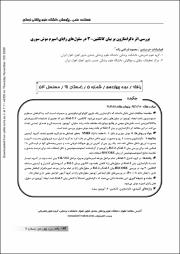| dc.contributor.author | Khorsandi, layasadat | en_US |
| dc.contributor.author | Orazizadeh, mahmood | en_US |
| dc.date.accessioned | 1399-08-21T21:42:00Z | fa_IR |
| dc.date.accessioned | 2020-11-11T21:42:01Z | |
| dc.date.available | 1399-08-21T21:42:00Z | fa_IR |
| dc.date.available | 2020-11-11T21:42:01Z | |
| dc.date.issued | 2013-02-01 | en_US |
| dc.date.issued | 1391-11-13 | fa_IR |
| dc.identifier.citation | Khorsandi, layasadat, Orazizadeh, mahmood. (2013). The effects of Dexamethasone on Galectin-3 expression in the mouse testicular tissue. scientific magazine yafte, 14(5), 63-72. | en_US |
| dc.identifier.issn | 1563-0773 | |
| dc.identifier.uri | http://yafte.lums.ac.ir/article-1-1112-en.html | |
| dc.identifier.uri | https://iranjournals.nlai.ir/handle/123456789/483131 | |
| dc.description.abstract | Background : Previous studies have demonstrated that Dexamethasone, a widely used GC, induces apoptosis in testis by decreasing the testosterone levels. Galectin-3 (Gal-3), a member of the ß-galactoside-binding lectins, plays critical roles in diverse biological events including cell growth, apoptosis, cell adhesion and immunomodulation. In this study, the effects of Dexamethasone (Dex) on galectin-3 (Gal-3) expression in the mouse testicular tissue were investigated.
Materials and Methods: Sixteen male NMRI (6-8 weeks old) randomly divided into two groups. Experimental group received 7 mg/kg Dex for 7 days by intrapritoneal injection. Control group received normal saline for 7 days by intrapritoneal injection.One day after the last injection the mice were sacrificed and the samples were collected (from adult NMRI mice), fixed in 10% buffered formalin and embedded in paraffin for immunohistochemistry and TUNEL studies. HSCORE was used for scaling and comparison of results.
Results: In the control group, seminiferous tubules showed positive immunoreactivity to Gal-3 at all stages. In particular, stages of VII-VIII showed the most immunoreactivity. The expression pattern of Bcl-2 and Galectin-3 was similar in both control and experimental groups.
HSCORE assessments showed a significant decrease in expression of Gal-3 at all stages of spermatogenic cycle in Dex treated mice (P<0.001). ). Apoptotic index (AI) showed a significant increase at all stages of spermatogenesis cycle in the experimental group (P<0.01)
Conclusion: Reduction in expression of Gal-3 in seminiferous tubules in Dex treated mice indicates that it probably involves in testicular germ cell apoptosis. | en_US |
| dc.format.extent | 320 | |
| dc.format.mimetype | application/pdf | |
| dc.language | English | |
| dc.language.iso | en_US | |
| dc.relation.ispartof | scientific magazine yafte | en_US |
| dc.relation.ispartof | مجله علمی پژوهشی یافته | fa_IR |
| dc.subject | Dexamethasone | en_US |
| dc.subject | Galectin-3 | en_US |
| dc.subject | Apoptosis | en_US |
| dc.subject | Testis | en_US |
| dc.title | The effects of Dexamethasone on Galectin-3 expression in the mouse testicular tissue | en_US |
| dc.type | Text | en_US |
| dc.type | Research | en_US |
| dc.contributor.department | Faculty of Medicine, Ahvaz Jundishapur University of Medical Sciences, Iran, | en_US |
| dc.contributor.department | Ahvaz Jundishapur University of Medical Sciences, Iran | en_US |
| dc.citation.volume | 14 | |
| dc.citation.issue | 5 | |
| dc.citation.spage | 63 | |
| dc.citation.epage | 72 | |





